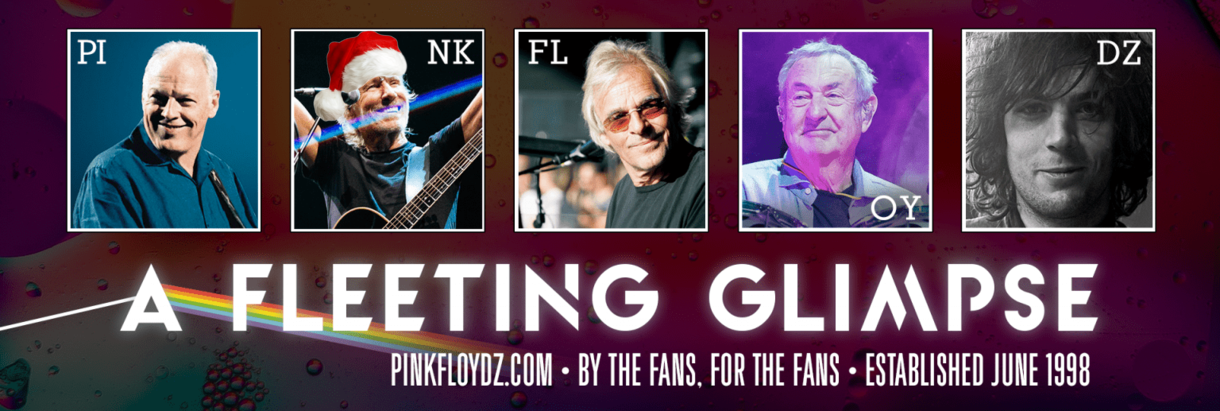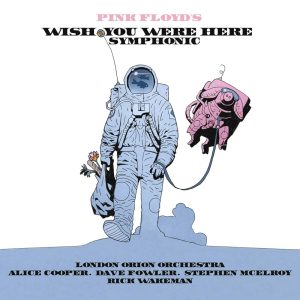An Exclusive Interview with Stephen McElroy
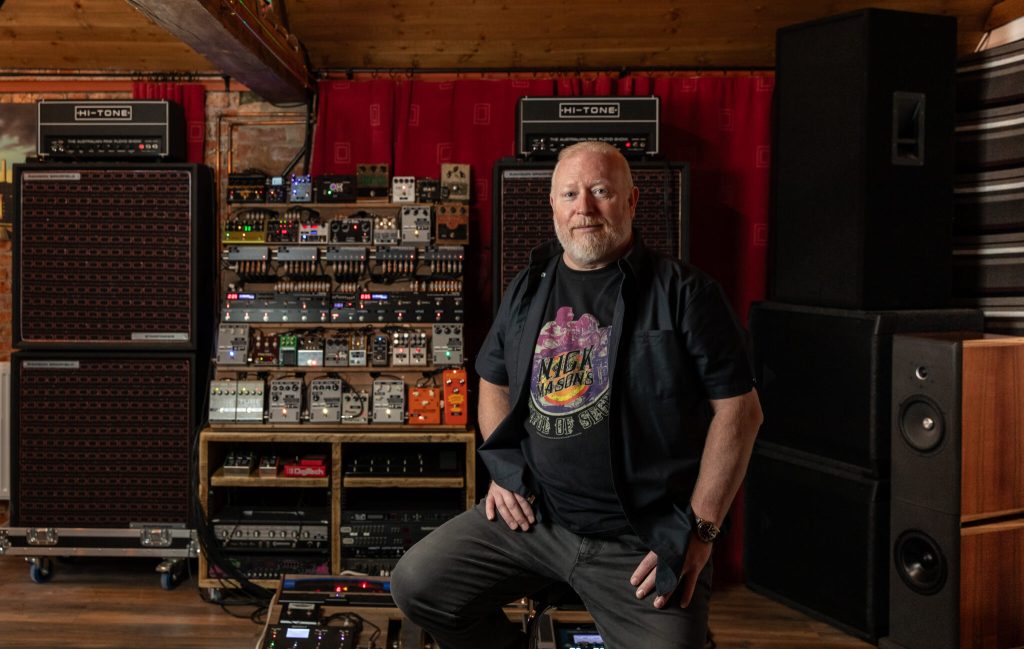
Photo by Bec Hughes
Stephen McElroy, known better as Steve Mac, is a key founding member of the famous Australian Pink Floyd Show, serving as their lead guitarist and vocalist since 1988. For three decades Steve has made a living meticulously emulating David Gilmour’s sound. While Steve has now taken a step back from the stage, he remains actively involved in managing the organization from behind the scenes.
AFG: Steve, it is a pleasure. Thank you for taking the time to speak with us. How is retirement treating you?
SM: And likewise Tony, I’ve been enjoying ‘A Fleeting Glimpse’ for many many years so it’s an honor to be interviewed. Thank you too for that flattering introduction, it would be nice to think I have been our lead guitarist for thirty-six years but in truth we’ve always had two guitarists in the band and we’ve always shared the guitar parts. When I first joined, Lee Smith actually played most of the lead guitar parts, but over time we shared them more evenly. We tend to play to our strengths which seems to work well. It’s true I have stepped back from the stage but I haven’t retired in the true sense of the word. If anything, I feel like I’m busier behind the scenes more than I have ever been. At first, it was quite daunting and I wondered if I’d get bored, but it didn’t take long for the void to fill.
AFG: How do you manage the Aussie Floyd while not physically on the road with the band? Are you the final say on the setlist, lighting, and everything in between?
SM: We are very lucky to have a team of extremely gifted and experienced people involved who have worked with us for many years. Some for up to thirty years. There’s over forty key individuals who all bring their magic to the show. It really is like a family and despite not being on the road anywhere near as much as I used to, I can sleep easy knowing that everything is in very good hands indeed.
Regarding setlists, I have always been particularly passionate about our setlist. Back in Adelaide, Australia we cut our teeth as a band listening to every bootleg of Pink Floyd we could lay our hands on. We used to all get together every Tuesday night after work for our ‘Bootleg Tuesday’ sessions. Listening to those live recordings and hearing the audience reactions would raise the hairs on the back of your neck. Just like their albums, Pink Floyd took the listener on an amazing emotional journey.
Their setlists were sculpted to perfection so that it flowed magnificently, up and down emotionally in places, and ultimately building up to a glorious climax. Pink Floyd created the blueprint, and it’s our job to recreate their genius as faithfully as possible. There’s a lot of consideration that goes into a setlist and we often tweak it once we’ve ‘felt’ the audience’s reaction. We strive to be diplomatic wherever possible, and after thirty odd years of experimentation there’s a kind of formula that we base the setlist on. It seems to work well globally. Like a great movie, there’s a dynamic in it’s structure that can really touch people’s hearts.
As far as everything else goes, it really is a team effort. Certain individuals obviously take care of their own specific departments but everyone is also open to suggestions from everyone. We value everyone’s input and sometimes fantastic suggestions come from the most unlikely of sources.
AFG: Let’s jump in the ‘Wayback Machine’, how did your journey start with Pink Floyd?
SM: I recall listening to a lot of my elder sister’s record collection…she was listening to Pink Floyd, Alan Parsons Project, Queen, The Beatles…mainly English bands. Growing up in Australia, you didn’t have a lot of choice, so if you had a record you typically wore that record out. I recall coming home from school after playing soccer. I was 13. It was a cold and wet day, and I was covered in mud, so I jumped into a hot bath. Meanwhile, my elder sister had just returned from the local record shop, and she had just bought a copy of The Dark Side Of The Moon. My parents were still at work, so she put it on the living room hifi and turned it up loud. Very loud. It filled the house sound and I recall lying in the bath and hearing all of these disturbing sound effects. Jackhammers, madmen laughing, a woman screaming. All getting louder and louder, and then it came to a crescendo and fell into Breathe. I just melted into the warm bath and from that moment on I was hooked.
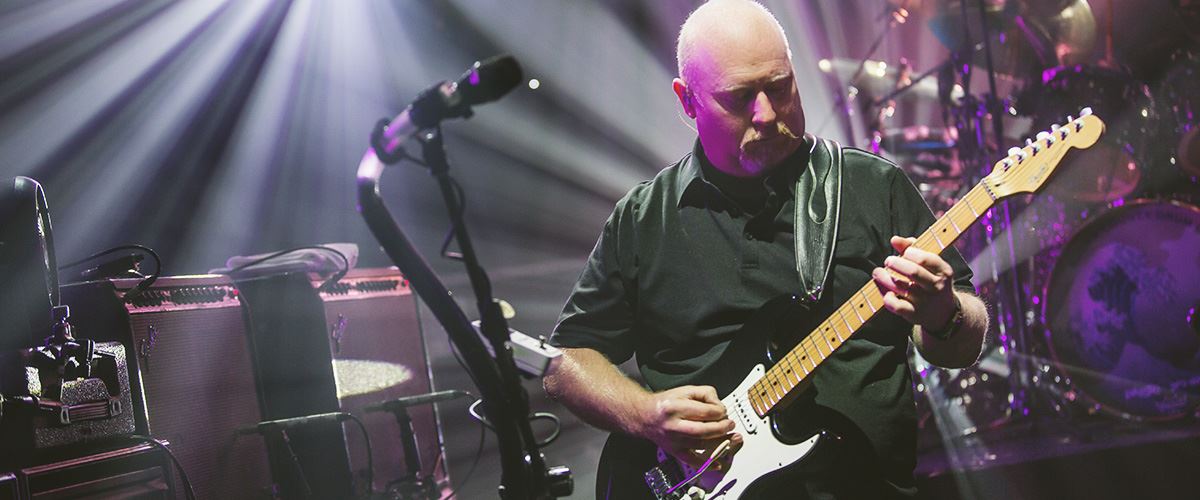
AFG: What made you want to play guitar?
SM: Sir David Gilmour. When I discovered Pink Floyd, and I fell in love with David’s playing and voice. That love has never wavered. He is such an inspiration. I was one of those many kids who would grab a tennis racket and pretend that I was playing his guitar solos. Finally, in my late teens, I saved up enough money to buy my first guitar and proceeded to learn how to play those beautiful guitar parts. I think memorizing every note prior to ever picking up a guitar really helped.
AFG: It’s been mentioned that you became part of Aussie Floyd in 1987 when Lee Smith, the founder, posted an ad in a local music shop, leading to you and keyboardist Jason Sawford landing the roles. Could you share some insights about the early days of that original lineup?
SM: I believe Jason answered the same ad, but it was in a different music shop. Lee’s ad was seeking like-minded people to play Pink Floyd music and to write originals. I was passionate about both, so I phoned Lee, and we hit it off immediately. We had so much in common musically and after a few hours on the phone, Lee invited me to audition the next weekend.
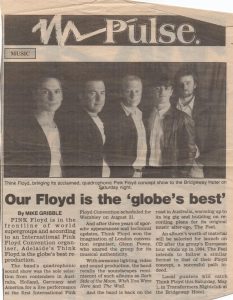
Coincidentally, Jason also auditioned the same weekend as I. It was in a drama classroom at a Primary School in Elizabeth. Lee had already been rehearsing for some time with Trevor Turton on Bass and Grant Ross on Drums. I recall hearing the trio for the first time that day while I was setting up my equipment. The guys were playing ‘Dogs’, and they blew me away. Jason then arrived and three became five. Aristotle is quoted for the phrase “The whole is greater than the sum of its parts’. It’s cliche, but it certainly was the case with us.
Jason was studying at University and the rest of us worked full time, so we rehearsed pretty much every weekend and some weeknights. We also spent a lot of time together just listening to Pink Floyd and then discussing it. Listening together was a really important part of our learning curve. Our first ever gig was at a birthday party, that led to a pub gig at The Alma Hotel in Adelaide, which in turn led to bigger pub and club shows in Adelaide. At the time, there was another Adelaide tribute band called “The Zep Boys” who obviously played Led Zeppelin songs. They were great and they had a strong local following. They also toured regularly nationwide, which enabled them to do it full-time.
That sounded like a dream come true to us, so, with that in mind, we approached Adelaide’s biggest Promoter “Adelaide Rock Exchange” and we were able to start touring nationally. We did so for a number of years, and it quickly became apparent that putting on a Pink Floyd show cost a hell of a lot more than putting on a Led Zeppelin show. We’ve always strived to use the best production we could afford, so we toured with a Quadraphonic PA system around Australia. It was totally unnecessary, but it sounded fantastic. We started doing bigger tours, which meant playing in more obscure places, but as much as we absolutely loved playing Pink Floyd music, it was ultimately a ‘pay to play’ scenario. It was hard yakka.
I recall us doing a show up near the northeast of Queensland. We’d just done a gig, and we had a 17-hour drive to get to the next gig and then do the show. We’d loaded out at midnight, then got in the vehicles and drove there. I drove one of the three vehicles. We drove non-stop and could hardly stay awake. We were exhausted.
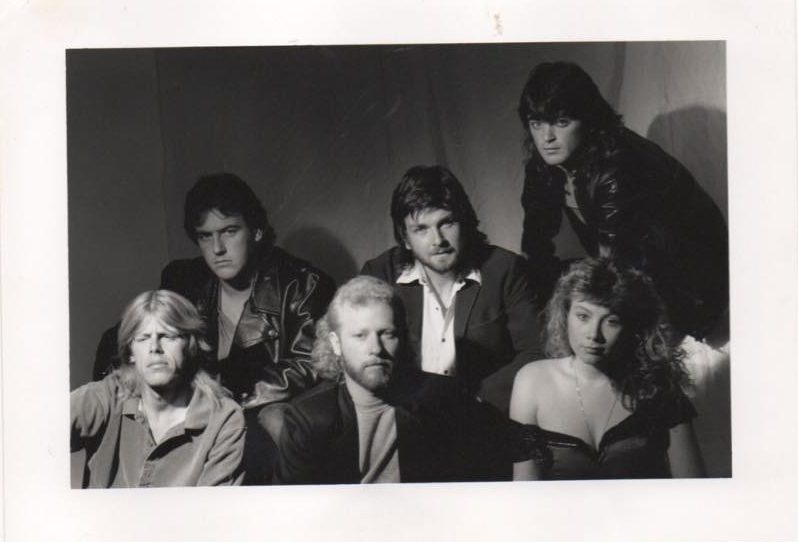
Original ‘Think Floyd’ band line-up L/R: Trevor Turton, Lee Smith, Steve Mac, Jason Sawford, Grant Ross & Debbie Horne
We finally arrived at 5pm and the show was at 7pm. We had all this heavy gear to load in. We set all the gear up and by the skin of our teeth we just managed to do it by 7pm but without a soundcheck. It was at a university. It was a big room, like a big basketball or gymnasium arena. We finished setting up, then the doors opened – and no one came in. Nobody. There was a single door at the back of the room that opened every now and then while we were playing.
There was a pool table in there with some students playing eight ball. Throughout the entire gig, every now and then, the door would open and someone would stick their head out with their pool cue in their hand waiting for their shot. They’d look at us, nod their head a few times and then shut the door, leaving us playing to nobody again. I recall spending the gig thinking I can’t believe we’ve nearly killed ourselves driving all that way and set up all that heavy equipment just for that! You gotta be crazy. But you learn to appreciate your audience from experiences like that. Playing for an audience who have been anticipating the show and who also appreciate every single note is such a privilege.
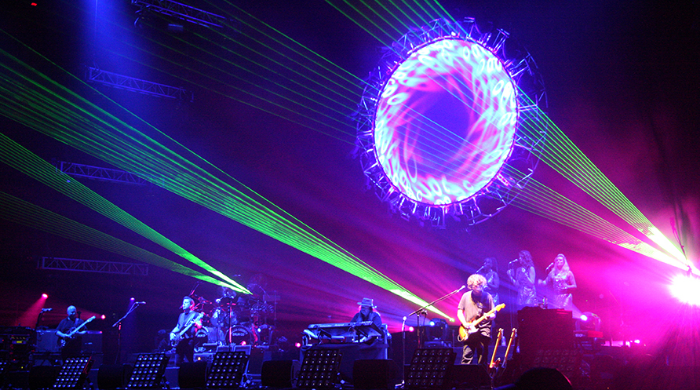
AFG: In 1993, Glenn Povey, the creator of the iconic Brain-Damage fanzine, organized a Pink Floyd fan convention in the UK, which featured a remarkable three-hour performance from the newly named (at the time) ‘Australian Pink Floyd Show’. Did you realize that this event marked the beginning of something significant with this band?
SM: I don’t think we did realized it. It was definitely our biggest achievement at the time, but we didn’t have much else in the diary after it. We couldn’t afford to transport ourselves and our equipment back to Australia, so we had no choice but to ask some of the band’s relatives who lived in the UK to put us all up. There were eight of us including our trusty roadies, and we were scattered all over the country, which as you can imagine, made things really difficult for touring, so Glenn helped us find a two-bedroom terraced house near London. It was tiny and some of us had to sleep on the floor and even on the staircase. So, at the time, things were pretty bleak and despite us having played at Glenn’s Pink Floyd fan convention at Wembley Convention Centre the significance of it didn’t really materialize until some time later. It took us a good few years before we could stand on our own two feet, but it would have never happened at all if it wasn’t for Glenn, and for that we are eternally grateful.
AFG: On the Aussie Floyd YouTube channel, you recount a fantastic experience of meeting David Gilmour backstage around 1994 after one of your shows, where he came to watch you perform and meet afterwards. Just two years later, in 1996, you had the amazing chance to perform at his 50th birthday party. What an incredible honor! How was that experience for you?
SM: You’re right Tony, it was an incredible honour. They are definitely some of the greatest personal highlights of our careers. It was surreal meeting David for the first time. We had just finished the show at the Festival Hall in London. We had a large single dressing room backstage and suddenly there was a knock on the door. This familiar smiling face peered around the door. It probably took us five or ten seconds for the penny to drop.
I mean, we all recognized it was David, but we simply couldn’t believe that it was David. Stood there, right there, in person. David Gilmour! I think I jumped out of my chair and started running around the room like a headless chicken. Once I gathered some composure, I approached David to shake his hand and thank him. He asked a few questions and I tried to string a few words together, but I cringe when I think about it now. It was one of those moments where you have fantasized about it for most of your life, and you have prepared all of these wonderful and gracious things to say but when I went to speak, my brain was way too busy tap dancing to connect to my mouth. The thirteen-year-old star struck kid inside me kicked in, and I think I replied to David with a load of childish gibberish. Before I knew it, the moment had passed and David and his entourage left. Our drummer Grant kindly handed me the bottle of beer that David was sipping from as a momento. I still have it 30 years on. In fact, I’ve used it to play slide guitar on some of my original compositions.
After embarrassing myself at Festival Hall, I decided I would try to avoid speaking to anyone at David’s 50th Birthday party. Fortunately, we were respectfully requested by the event manager to keep to ourselves, be polite, don’t get in anyone’s face or anything, and we really wanted to respect that, so we did. It was David and his guests who approached us. They were all so kind, and they went out of their way to make us all feel very welcomed that day.
It was held at Fulham Town Hall, and there was theatre in there. It was set in a 60s vibe. So they had Persian rugs on the floor, an ice sculpture in the middle, and apparently some people doing body paintings. The food was magnificent. I had the best cream cheese and smoked salmon sandwich I’ve ever had in my life. To this day, I’ve never had a sandwich as delicious as that. The evening’s entertainment was terrific. There was a magician there who got David involved in his act and the Bootleg Beatles played as well. They were fantastic, it was a great night.
Finally, we took to the stage and performed the setlist that David had put together. I do remember having George Harrison sat on the floor in front of me while we were playing through our set, in his 60s outfit, smoking a cigarette the size of a toilet roll. I’m not sure what was in it, but he seemed to be enjoying himself. Towards the end of the set, David was coaxed by Rick Wright to get up on stage to offer us all some of his magic. He climbed up on stage and I got down on my knees and held my guitar up to him as if I was handing Excalibur to King Arthur. David took my guitar, looked down at my pedal board and casually asked ‘So how d’you fly this thing?’. Which I thought was really cool because I’m into aviation in a big way.
I pointed David to a few sounds, and then he began to twiddle the knobs of my guitar and press buttons. He just turned my guitar rig into the best it’s ever sounded, and off he went and played a couple of songs, to the delight of everyone that was there. It was great, magical. I was buzzing for days, I couldn’t sleep. I got home that night and I just sat on the couch and thought ‘I can’t believe that just happened’. I still have the strings and the plectrum that David played on that guitar, and I still use that guitar. It was very, very magical.
AFG: Since 2004, Australian Pink Floyd has been a touring powerhouse, performing across the USA, Canada, Germany, and Italy, and they maintained a demanding touring schedule in the years that followed. Did you ever imagine in your wildest dreams that you would be playing in large venues just like the original band? Let alone having a similar demanding tour schedule!
SM: Naively and optimistically we did, I guess. I recall a time when we were back in Adelaide in 1992, we had secured Glenn Povey’s Pink Floyd Convention gig, and we had 12 months to prepare for it, so we pooled our money, rented a big house and set up a rehearsal studio in it. We all moved in, and we rehearsed five nights a week and gigged on the weekends. I still worked full-time and my work held these group brainstorming sessions. They were designed to look at how to improve things. They were a great way to get everyone contributing and thinking outside the box.
Everyone bounces off each other and things can really snowball. We started having them as a band. Sometimes verbally as a group and sometimes we’d ask a question, and we would each go away and write about it, then reconvene in a week and compare notes. One question was… “Where do you see the band in 10, 20 & 30 years’ time?” Well, everyone had answers and surprisingly, everyone did see the band still being together in 10, 20 & 30 years.
That really reinforced our belief in one another. It was very encouraging to all of us at the time, to pledge that long-term commitment to this risky venture. Without that pledge, we may have not have had the courage to quit our jobs, leave our families and friends and basically start a new life on the other side of the planet. So, I guess we must have had faith and belief that this could have legs. We believed in each other, but ultimately that only came about because we all believed so strongly in Pink Floyd.
AFG: In your career as a touring musician, you have played some really illustrious venues, from Battersea Power Station to Wembley Arena to Jodrell Bank, which venue sticks out in your mind as the most unique?
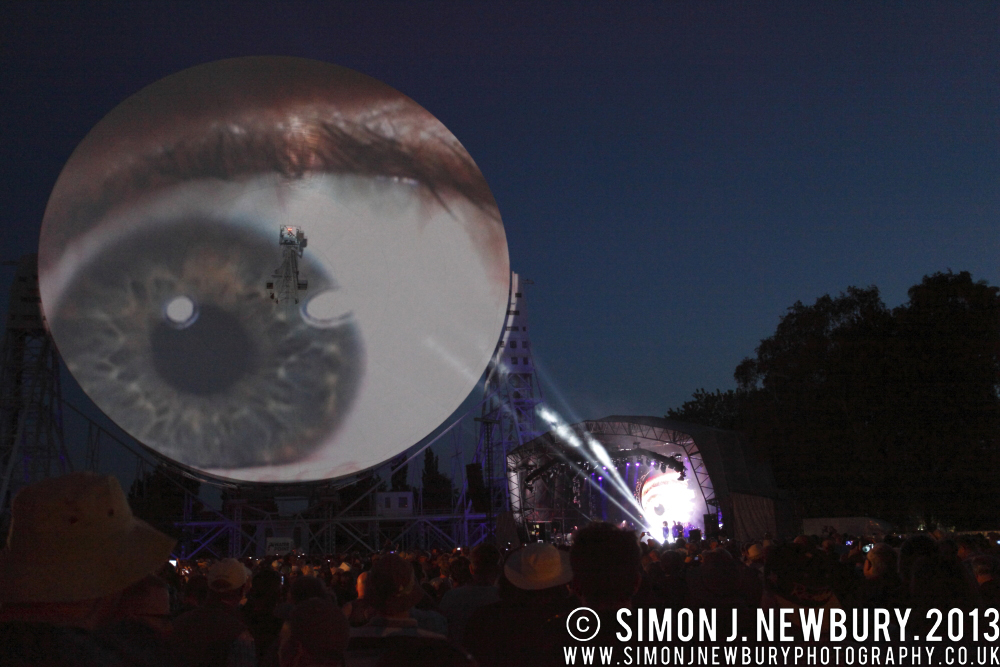
SM: Probably Jodrell Bank. That was out of this world, and like a trip back in time. We shared the bill with Hawkwind. They were great. They set the scene for the night and took the audience into a great mindset, ready for a nice fat serving of Floyd. It was incredible to project all of our screen content on to Jodrell’s 250 foot dish. We could also watch it from the stage whilst playing. It was a really cool vibe.
AFG: In 2011, Guy Pratt joined you and the band on stage for Run Like Hell, how did that come about?
SM: In 2011, we held a private preview of our Quadraphonic and 3D tour at a TV studio in London and Guy attended it. I believe conversations were had between Guy and Management, which later resulted in an invitation to join us at Hampton Court. Guy kindly obliged and the rest, as they say… It was great to share the stage with Guy, and one thing that really stood out to me during our soundcheck was just how strong Guy’s voice was. He’s got a great set of pipes. I’m a massive fan of Nick Mason’s ‘A Saucerful Of Secrets’ and I have to say it’s lovely to hear Guy singing some lead vocals. I particularly love his vocals on “If”. They are sublime.
AFG: That same year, you brought 3D technology to your performances, allowing the audience to wear 3D glasses to view the projections, a feature the original Pink Floyd never attempted. Was it a priority for you to continually explore new technologies in live shows to enhance the visual experience?
SM: You know those brainstorming sessions I mentioned earlier?… We also posed the question.. “What technology can you see us using in the future?” Mind you, it was 1992, but I remember discussing putting the show in a dome and projecting images over the entire internal walls. I also discussed having hundreds of speaker clusters throughout the dome to provide a fully immersive multitrack surround sound experience for the audience. I still have copies of the notes in my memorabilia collection. Fast forward 31 years and to my amazement, they’ve only gone and built one in Las Vegas. The Las Vegas ’Sphere’ is precisely what we envisioned 31 years ago, albeit considerably larger. Boasting 164,000 speakers and 16K LCD screens, the Sphere would be the ultimate venue for a Pink Floyd concert. I am hoping that David, Roger or Nick may play there one day, but who knows, maybe our 1992 fantasy could come true?
AFG: In 2016, Pete Smith took the lead in creating and producing ‘Pink Floyd’s Wish You Were Here Symphonic’, a project that beautifully reinterprets the classic album by blending rock with orchestral elements. This collaboration features yourself, Aussie Floyd’s Dave Fowler, along with Rick Wakeman and Alice Cooper, and was recorded at Abbey Road, the same iconic studio where the original album was made. Could you share more about that experience?
SM: Being involved in Pete’s project was definitely a career highlight. It came about via our management, in particular Kevin Hopgood who suggested they get me in to lay down the guitar parts. I thought it made more sense to have both Dave Fowler and I do it as we could simply turn up with our guitar rigs and play the parts that we had already been playing for many years. They went with that, and it worked out really well. To us Pink Floyd fans, Abbey Road is like Mecca, so recording there was yet another dream come true and an absolute privilege.
It was very special indeed to stand in Studio 2 and picture all of the many artists recording such a vast catalogue of music that we all love so dearly, particularly Pink Floyd. It was quite overwhelming to say the least, and quite surreal to be recording in the very room where Pink Floyd recorded their opus The Dark Side Of The Moon. I immediately noticed the patterned wooden floor that I had seen so many times before in Pink Floyd’s ‘Live At Pompeii’ film. I was standing on holy ground. No pressure then. The Beatles also mainly recorded in there too, and that’s where we recorded our guitar parts. First with an orchestra and then at another session by ourselves.
I was given an hour to warm up before one session and, by chance, Abbey Road’s biggest room… Studio 1 was unoccupied, so I took my guitar in and walked around playing it uninterrupted for an hour. This was the very room that David recorded his legendary four note “Syd’s Theme” from Shine On You Crazy Diamond. I also noticed a grand piano, apparently the very piano that Rick Wright recorded Great Gig In The Sky and Us And Them on. Wow. If only it could talk.
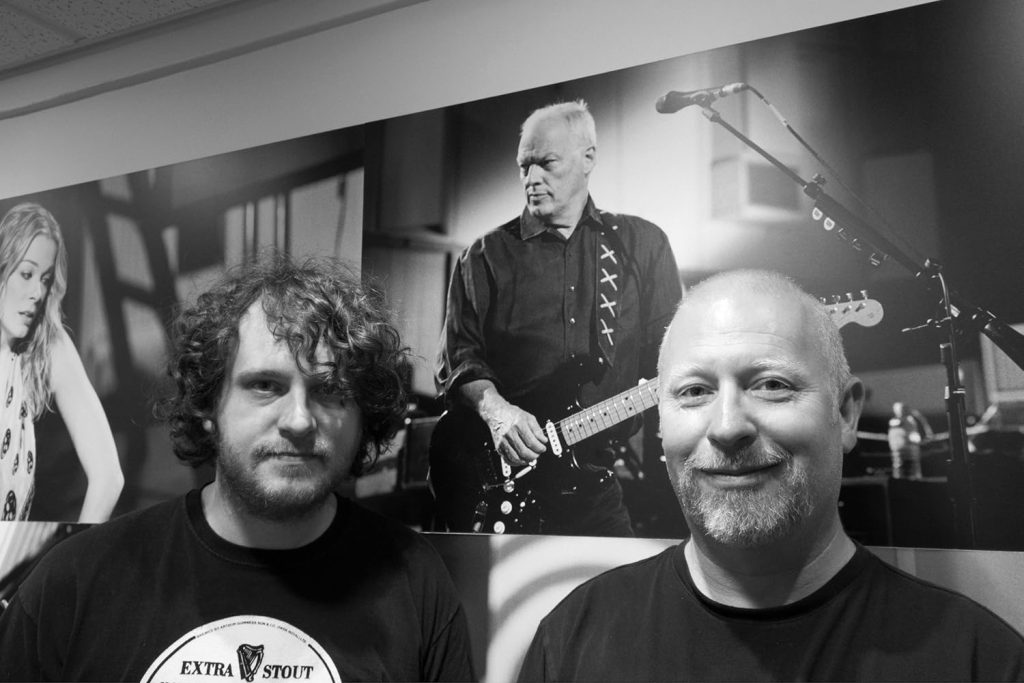
Dave Fowler and Steve Mac at Abbey Road
A few weeks later, I helped mix down the guitar parts. It was a quiet day at Abbey Road and a lot of the control rooms were empty, so I was able to check them out. There was still a lot of vintage recording equipment from the 60s and 70s loitering in corners or pushed up against corridor walls. The smell of them was magnificent. The aroma of bakelite and old circuit boards was intoxicating. As someone with a background in electronics, it was heaven. Great memories.
AFG: Are you working on anything at the moment?
SM: I’m afraid I can’t say. A gentleman never tells.
AFG: Would you ever consider going back out on the road again? Or playing a limited amount of shows?
SM: Having spent over half of my adult life being away from my loved ones, I feel I now owe it to them to make up for it, especially my good wife. I may decide to dust off that guitar and play live again one day, probably with a new project, but for now I am enjoying the silence. It’s also refreshing to be able to just focus on being a fan again. Enjoying it all from the other side of the stage. It’s how it all started in the first place. It’s like rediscovering yourself. So the answer is I don’t intend to, plus I feel there’s no need as I couldn’t be happier with our line-up and how the show is going.
AFG: Do you get out to see the active members of Pink Floyd still? (Nick Mason’s Saucerful Of Secrets, David Gilmour and Roger Waters)
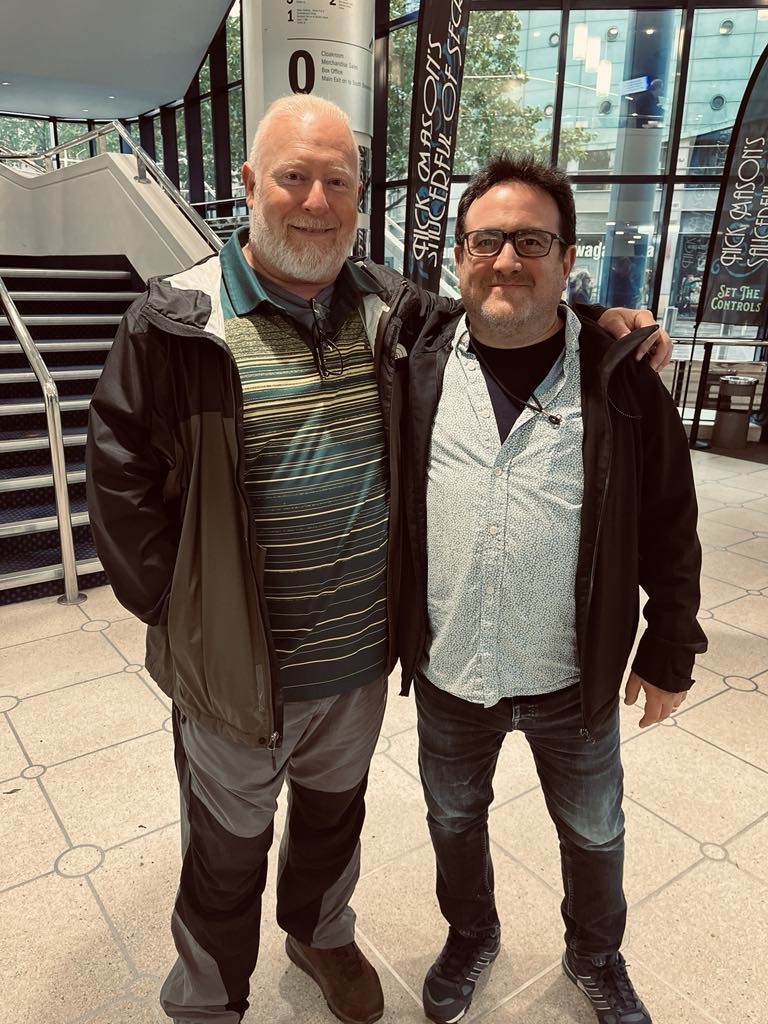
Steve with Lee Harris
SM: I certainly do. I’m a fan first and foremost. I always will be, and I’ll be trying to see as many shows as possible. Quite often we are on tour ourselves, so we typically miss out, however I am now able to see my heroes more often. I’m looking forward to seeing David at the Royal Albert Hall for a few shows in October. I love his new album ‘Luck and Strange’ and from what I’ve seen, he’s put a cracking setlist together for the tour.
AFG: Being the Gilmour fanatic, you are a massive gear head. In the YouTube video series you go through your massive home rig, are you collectively adding to it all the time? Have you chopped and changed a few things since?
SM: I have, it’s always a work in progress, searching for the elusive sonic holy grail etc. I have been turning my attention to my guitars lately and looking at how I can improve them. It’s easy to get obsessed with effect pedals, rack mounted gear, amplifiers, speakers, microphones, cables etc and end up overlooking the guitar, which is really where the magic is created. I am particularly guilty of this. If a guitar didn’t sound right, I’d typically engage an array of effect pedals to try and fix it. It was actually Dave Fowler who opened my outlook on guitars.
Dave has a vast and stunning collection of guitars, and he employs several of them for the show. He changes them regularly depending on the setlist for that year, whereas I preferred to stick to my two old faithful Strats. We were graced with a visit backstage by Steve Howe from Genesis. He asked me what guitars I used, and I answered mainly two. He then went on to say I should try to use a single guitar wherever possible as over time it becomes a part of you and an extension of your body and soul. Playing Pink Floyd’s music is obviously vastly different to playing Genesis’s music, but I took onboard what Steve said, and have gone back to my guitars to try and make them play and sound as nice as possible. It’s been a great learning experience.
AFG: In 2021, Westley Bone from Troglodyte Music and Chris Hewitt of CH Vintage Audio collaborated to recreate the rig Pink Floyd used while filming Live at Pompeii. You and some of your Aussie Floyd bandmates were invited to perform a ‘Pompeii’ style set using this rig and filmed it. What led to your involvement on this unique project?
SM: It was actually Lee Smith who brought my attention to Chris Hewitt. I had seen Chris advertising some of his products before on eBay and Facebook groups etc, but I hadn’t realized that he owned such an incredible amount of vintage PA equipment. When I first spoke to Chris, he was developing exact replicas of David Gilmour’s 4 x 12” Fane loaded WEM guitar speaker cabinets. In fact, he had tracked down and bought the original machine used to manufacture the magnets from David’s speaker of choice, the 12” Fane Crescendo. Chris also produced exact replicas of the heavy cast steel speaker baskets instead of using the thin pressed steel baskets of today, he also sourced the same paper to make the speaker cones, resulting in the closest thing to the real deal. It was his attention to detail that really impressed me. A man after my own heart, so to speak.
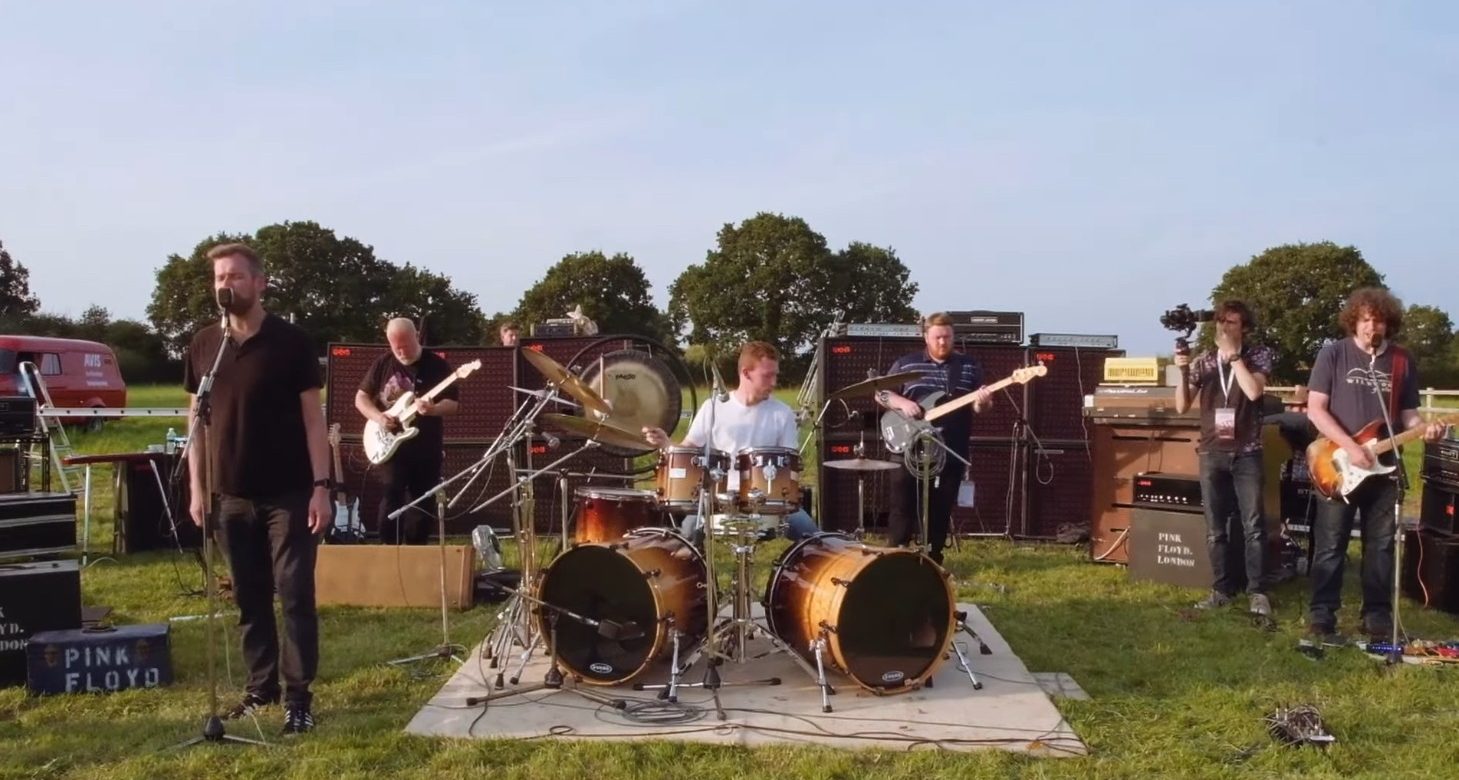 We started chatting and Chris revealed that he had purchased the original PA that Pink Floyd used during their ‘Live At Pompeii’ era. He also purchased the PA that Pink Floyd toured with during their Dark Side Of The Moon era. It had been one of my fantasies to recreate Live At Pompeii for many years and Chris also had the vision of somehow recreating it using the original PA. Chris decided to give it a trial run and was going to set up the PA in the middle of a field he owned and play recorded music through it. He phoned me a few days before to invite me over for it and one thing led to another. I spoke to the guys and those who were available kindly came up, and we had a bash at 4 or 5 songs. We ran through them twice and filmed it on the second run. The PA certainly has a sound to it, and it was another one of those ‘I need to pinch myself’ moments.
We started chatting and Chris revealed that he had purchased the original PA that Pink Floyd used during their ‘Live At Pompeii’ era. He also purchased the PA that Pink Floyd toured with during their Dark Side Of The Moon era. It had been one of my fantasies to recreate Live At Pompeii for many years and Chris also had the vision of somehow recreating it using the original PA. Chris decided to give it a trial run and was going to set up the PA in the middle of a field he owned and play recorded music through it. He phoned me a few days before to invite me over for it and one thing led to another. I spoke to the guys and those who were available kindly came up, and we had a bash at 4 or 5 songs. We ran through them twice and filmed it on the second run. The PA certainly has a sound to it, and it was another one of those ‘I need to pinch myself’ moments.
Chris has since built a working replica of Pink Floyd’s quadraphonic mixing desk. We occasionally invite him to exhibit his Pink Floyd PA’s at our shows. It gives the hardcore Floyd fans a special treat.
AFG: Is the pre-Dark Side era your favorite of Pink Floyd’s?
SM: To be honest, I love all of Pink Floyd’s music, but I do have a particular fondness of that era. I spent my youth listening to bootlegs of Pink Floyd experimenting live and gradually developing those early albums. Their musicianship and chemistry on stage is an inspiration. That’s the reason I wanted to do this and performing those classics has always filled me with a wonderful sense of romance and nostalgia.
AFG: What is next for Steve Mac?
SM: It’s business as usual really, just minus the guitar. I’ll always be a fan of everything that is Pink Floyd. It is my healthy obsession and I can’t ever see that changing. I love what we do, and I’m very proud of everyone involved and of what we have achieved over the last thirty-six years. I will, of course, support my Aussie Floyd family in the hope that we will continue to provide the best and most respectful tribute possible celebrating Pink Floyd’s legacy and their genius.
The Australian Pink Floyd Show are currently on tour and you can view all dates and buy tickets here: https://www.aussiefloyd.com/tour-dates
